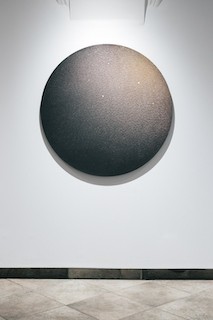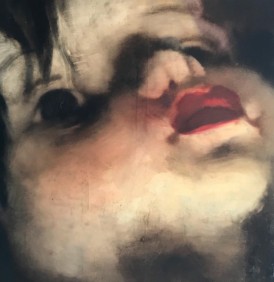About
Milky Way
Kurator: Łukasz Huculak
17.12.21 – 29.01.22
Milky Way
Curator: Łukasz Huculak
17 December 21 – 29 January 22
Agnieszka Apoznańska / Aleksander Baszyński / Paweł Baśnik / Wiktor Gałka / Łukasz Huculak / Zuzanna Janosz / Justyna Klecka / Tomasz Kwiatkowski / Kami Mierzvvisk / Paulina Rega / Jacek Wasilewski
The presented exhibition is a tribute to the visual potential of Stanisław Lem’s literature, paid to the author in the year of the anniversary of his birth. The artists invited to the exhibition were asked to create paintings inspired by his work. They are mainly students and graduates of the Academy of Fine Arts in Wrocław, associated with the painting studio of Prof. Łukasz Huculak
Solaris is sometimes accused of poor characterisation of the protagonists. To Lem’s excuse, it should be said that they are flat, incomplete and hardly plastic only against the background of exceptionally picturesque “descriptions of nature”, creations of “gravitational jelly”: mimoids, symmetriads, rapidos, and extensors. The landscape of Solaris is doubly painterly, not only because of its picturesque surface, but also because of its ontological status. It is not the original but a copy, a kind of representation, an image – an artefact. More than an external reality, the fluid stream of fanciful shapes represents the interior of the human psyche. An infinite number of thoughts and imaginings of uneven “finish”, sometimes fully developed and legible forms, at other times only vague predictions of them, vague intuitions, flashes of consciousness drifting in the depths of the unconscious. For thoughts are not just meaningful sentences that are a particular emanation of consciousness. Psychic life also manifests itself in vague conglomerations of words, images and emotions, founded closer to the physiological level of reactor-brain processes. It is their richness that is reflected in the shapes formed by the sentient ocean.
They evoke threefold associations from the history of painting. The rings of collapsing waves of the abortive mimoid are reminiscent of the magmatic, ungraspable sensual “pre-formal” state of matter of Jackson Pollock’s paintings or the Tachists. The “polyp-like excrescences” of the mature mimic, whose aim is to “copy external shapes”, seem to reflect the imaginarium of surrealism. The gardens and walls observed by Berton, which from on high look like a city (although this is an illusion “arising from the need for any sort of analogy with something familiar”), correspond to the landscapes of Max Ernst, the visions of René Magritte or the liquid wilderness of Yves Tanguy. Finally, the symmetry, reminiscent of soaring Gothic, “a relative of Lobachevsky’s cones and Riemann’s negative curvatures”, which weaves into its form the parameter of time and the aspect of changing vision, resonates with the visual explorations of Cubism.
The Solarian ocean represents a new biological form, generating emotional states without the mediation of the perceptual apparatus – directly in the brain. In Lem’s terminology – an “electrochemical reactor”, a kind of hyper-intelligent plant that, instead of moving and traversing space to gain access to energy sources, triggers all the processes necessary to sustain life directly in the organ responsible for processing them. Although the association of the Solarian ocean with the Berkeleyan “spirit” that induces sensual impressions in the minds of people may seem unwarranted, the author himself hints at this clue: the plasmatic container “passed time engrossed in theoretical reflections [...] concerning the nature of the universe”.
A colossal nervous system in the form of a celestial body, an “organic formation” that “[model] space-time specifications” and speak the language of mathematics (electromagnetic impulses). “A ‘brilliant ocean’ ‘that doesn’t build cities or bridges, or flying machines; it doesn’t try to conquer space or cross it [...]. Instead, it occupies itself with thousand fold transformations – ‘ontological autometamorphosis’.”
Curator: Łukasz Huculak
Display









































